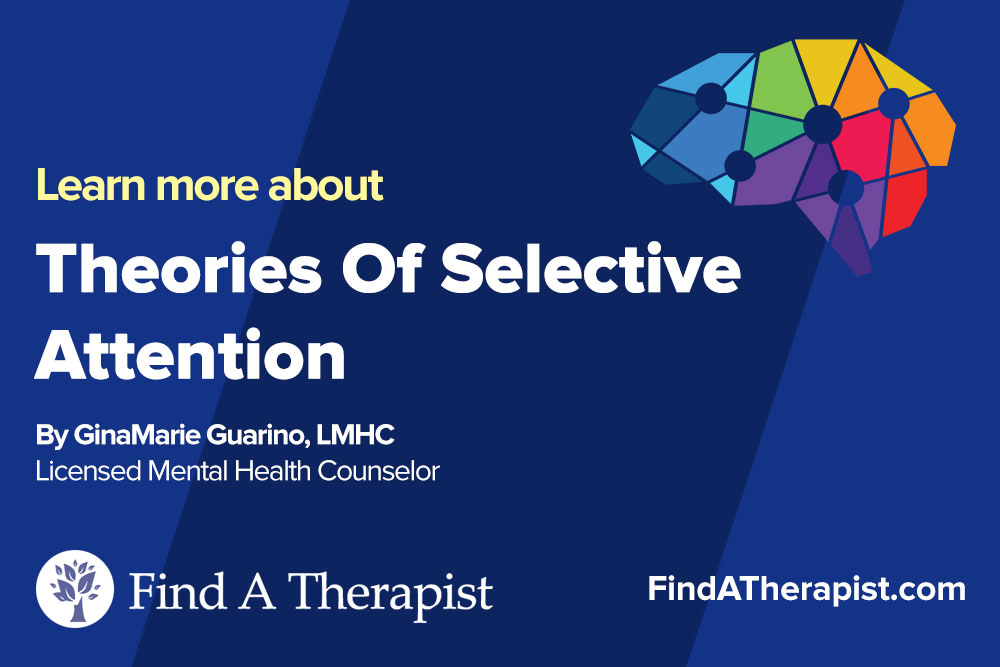Theories Of Selective Attention
Published on August 27th, 2020
Updated on January 2nd, 2024

Contents
Selective attention is the process of focusing on certain environmental factors while ignoring others. In any given moment, a person is exposed to a significant amount of environmental stimulation. Typically, we use selective attention to cancel out sensory stimuli. This allows us to focus on one thing at a time.
People use selective attention throughout their day. There is so much environmental information to take in at any given moment. If we were not able to use selective attention our senses would always be overwhelmed. We would struggle to process information as a result of overwhelmed senses.
Sponsored by

Choose a therapist to work with and start healing with 20% off from BetterHelp.
Click HereSelective attention serves an important purpose. It contributes to the ability to process information. It also aids in the ability to make memories. Some people are better at canceling out stimuli than others, but selective attention is an important part of information processing for everyone.
Example: Eileen and Bobby are eating dinner at a busy restaurant, which has a lot of environmental stimulation. There are conversations happening around them. There are waiters and customers passing tables to and from the kitchen and bathrooms. There is music playing and the smell of food is in the air.
Eileen and Bobby are able to enjoy a meal together because they have the ability to use selective attention. They are able to ignore the activity of other people and smells in the air. This gives them the ability to focus on each other. They are able to give their attention to the conversation, and only pay attention to what is happening at their table.
Visual Attention
Attention is directed through the senses. As humans, we tend to use the senses of sight and sound to navigate our environments and make decisions. This means that humans rely heavily on visual attention. They use what they see to assess their environment.
Visual attention is focusing on information being observed through sight. It is the process of taking information from what we see and choosing to pay attention to that information. The attention comes from canceling out other environmental factors and focusing on the point of interest.
Example: Kaitlyn is at the park. She is enjoying the nice weather and green hills. She sees children playing, frisbees being thrown and dogs being walked.
On the baseball field, she notices Dave. Dave is an attractive man with a great sense of style. Kaitlyn finds Dave attractive, so her attention switches to Dave. Kaitlyn is able to cancel out the rest of the environmental stimulation and focus only on what Dave is doing.
Auditory Attention
Similar to visual attention, auditory attention is the process of canceling out what we hear to focus on what we are listening to. At any moment, the human ear is hearing many different things. Most of the things we hear go unnoticed. With selective attention, we are able to ignore most of what we hear, and direct our attention onto what we want to focus on.
Example: Josh works on a construction site. All day long, he hears machinery powering. He hears saws, motors, and cranes. He hears screeching sounds, loud bangs, and hammering all day long. Even though he hears all of these sounds, when Henry asks him a question, he is able to answer.
Josh has the ability of canceling out all of the other noises around him to focus on Henry’s question. He is able to place his attention on what Henry is saying, without confusion from the construction work.
Broadbent’s Filter Model of Attention
Donald Broadbent was an English psychologist who developed the Filter Model of Attention in the late 1950’s. In this model, Broadbent proposed that a person chooses where to put their attention based on the physical qualities of the stimulus.
In his theory, Broadbent explains that sensory information enters consciousness through a filter. This filter is used to determine what stimuli the brain will give its attention. The stimuli that is chosen for attention is passed through the filter. Stimuli that is not passed through the filter is no longer in the awareness of the subject.
This process prevents overstimulation of the senses. It prevents the brain from becoming overwhelmed with sensory information. The process helps by allowing the brain to process information that is in attention. The information that is in attention may or may not be processed into memory.
Dichotic Listening Task
Broadbent performed the dichotic listening task to develop the Filter Model of attention. The task assessed the process of selective attention and information processing. The dichotic listening task presents a subject with two different sets of auditory stimuli. The stimuli may be two different melodies, sounds or storylines. Each stimuli is played at the same time. The subject is given a set of headphones, and each ear is played a different stimulus.
During the test, the subject is instructed to either listen to the right ear, left ear, or both ears at the same time. They may be hearing different songs, sounds or stories in each ear. The results indicated a challenge with paying attention to both stimuli at the same time. Subjects found it easier to focus on either one ear or the other.
The brain of the subjects needed to filter the information. They focused on information from one ear and did not pay attention to the information from the other ear. As a result, the subject was able to recall details of the stimulus that had their attention. The subject did not absorb much detail about the stimulus that did not have the subject’s attention.
Treisman’s Attenuation Theory
The Filter Model of attention inspired Treisman’s Attenuation Theory. Treisman’s attenuation theory was developed by Anne Treisman in 1964. Like Donald Broadbent, Treisman was an English psychologist whose research focused on cognition, attention and information processing.
Treisman’s theory supports that attention is based on Broadbent’s Filter Model. Treisman agreed that stimuli is filtered before reaching the attention of the subject. Treisman’s argument was that the stimuli that were not given attention does not leave a person’s awareness. It fades into the background, but information about the environment is still being processed by the brain.
Example: Leanna is shopping at the local grocery store. While shopping, she is able to focus on her grocery list as she walks down the aisle. While not in her immediate attention, she notices through her periphery that she is passing the peanut butter. Leanna knows that peanut butter is on her list, so she is able to redirect her attention from the list and on to the peanut butter. This is because while the aisle did not have her attention, her brain was still taking in peripheral information about the environment.
Treisman’s attenuation theory suggests that the sensory stimuli that are not given attention does not leave the awareness of the brain. Instead, the stimuli is attenuated. This means that certain stimuli become less powerful and prominent, but it does not leave a person’s awareness. The stimuli that is not attenuated becomes more significant to the senses. The stimuli that is attenuated fades into the periphery of sensory awareness. The stimuli is still recognized by the brain, but it is not as strong as the stimuli that has gained the subject’s attention.
Sponsored by

Find an affordable therapist online with 20% off from BetterHelp.
Click Here






Leave A Reply